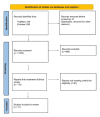Efficacy of High-Dose Statins in Preventing Contrast-Induced Nephropathy Post-cardiac Catheterization
- PMID: 40330333
- PMCID: PMC12054600
- DOI: 10.7759/cureus.81795
Efficacy of High-Dose Statins in Preventing Contrast-Induced Nephropathy Post-cardiac Catheterization
Abstract
Contrast-induced nephropathy (CIN) is defined as an increase in serum creatinine (s-CR) of at least 0.5 mg/dL or a 25% or greater increase from baseline within 48-72 hours of contrast agent administration. High-dose statins have been proposed as a prophylactic measure against CIN. This updated systematic review and meta-analysis aimed to assess the efficacy of peri-procedurally administered high-dose statins in preventing CIN in patients who underwent cardiac catheterization. A comprehensive literature review of PubMed and Embase was conducted with a distinct focus on studies published in the last 15 years up to June 2024. The study included randomized controlled trials (RCTs) that assessed the impact of high-dose statin treatment during or around the time of cardiac catheterization on the rate of contrast-induced nephropathy (CIN). It excluded trials comparing low-dose statins or statins used in non-cardiac surgeries, as well as studies with missing data or unclear end points on CIN. The primary objective was to evaluate the efficacy of high-dose statins administered peri-angiography to prevent CIN. Random effects were used using the DerSimonian and Laird method. A subgroup analysis was performed to assess the effectiveness of high-dose statins in preventing CIN in patients on chronic statin therapy. Our pooled analysis of 2,312 participants revealed a significantly lower incidence of CIN (odds ratio (OR): 0.47, 95% confidence interval (CI): 0.30-0.72, P = 0.0007, I2: 38%) in the high-dose statin group compared to the control group. However, the subgroup analysis showed no benefit of high-dose statins in decreasing the incidence of CIN in individuals already on chronic statin therapy (OR: 1.03, 95% CI: 0.33-3.18, P = 0.97). Our study highlights the beneficial effect of high-dose statins in preventing CIN in statin-naive patients. However, no benefit was observed in patients who were on chronic statin therapy.
Keywords: chronic statin therapy; contrast-induced nephropathy; high-dose statins; outcome; percutaneous coronary intervention.
Copyright © 2025, Elkholy et al.
Conflict of interest statement
Conflicts of interest: In compliance with the ICMJE uniform disclosure form, all authors declare the following: Payment/services info: All authors have declared that no financial support was received from any organization for the submitted work. Financial relationships: All authors have declared that they have no financial relationships at present or within the previous three years with any organizations that might have an interest in the submitted work. Other relationships: All authors have declared that there are no other relationships or activities that could appear to have influenced the submitted work.
Figures




References
-
- Reports on contrast media reactions: analysis of data from reports to the U.S. Food and Drug Administration. Lasser EC, Lyon SG, Berry CC. Radiology. 1997;203:605–610. - PubMed
-
- Contrast-induced nephropathy: definition, epidemiology, and patients at risk. Mehran R, Nikolsky E. Kidney Int Suppl. 2006:0–5. - PubMed
Publication types
LinkOut - more resources
Full Text Sources
